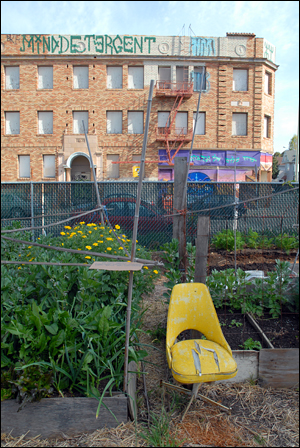
In 2009, urban farming, like punk in 1991, broke. While San Franciscans have been raising chickens in backyard coops and tending verdant patio gardens for decades, the trend has now sprouted up in the city's mainstream, expanding from the realm of co-ops and collectives to the mayor's cluttered desk: In July, Gavin Newsom issued an executive directive aiming to reshape how city residents make food choices, and now, eight months later, neighborhoods and communities are beginning to taste the (literal) fruits of City Hall's efforts in the form of initiatives like public vegetable gardens and mobile produce markets. In recent years, urban farmers have started seeing their flora and fauna as something more than sustainable, super-local eats. They're hyper-aware of how their work can impact their surroundings, and intrigued by what larger ripples they might make. Thus, their missions are evolving, moving in inspired directions towards a brand of community-conscious agri-activism.
Having a president keen on arugula and a first lady tilling soil outside the White House helps, but the movement has found creative, diverse expression locally. Brooke Budner and Caitlyn Galloway run Little City Gardens, a miniature Mission District farm and salad greens business. The founders see their project as "an experiment in the economic viability of small-scale urban market-gardening," a working model for a career path they'd like to see become more common in America. The greens are fantastic -- as knows anyone who has crunched down on a Bar Tartine salad -- but producing good food for people who care is only a facet of the over-arching goal; it's about the people too -- which probably has something to do with the ongoing success of their Kickstarter-funded expansion campaign. Since 1994, Alemany Farm has gone by a few different handles, but the 4.5 acre South Mission garden, tucked away along the intersection of two major highways, staffed largely by volunteers and neighborhood residents, remains committed to growing food and creating jobs for citizens in low-income communities. Craigslist -- you know, that site we used to use for finding jobs -- is a cornucopia of produce. Its farm and garden classifieds always bristle with city farmers looking to unload excess hauls -- whether they be bunnies, bok choy, or Meyer lemons. Novella Carpenter has raised turkeys, goats, pigs, bees, chickens, geese and rabbits in the backyard of her house in Oakland -- everything "short of a cow," she professed in a February 2009 interview with the aptly named Twilight Greenaway of Culinate. Along the way, Carpenter has never identified her efforts as a model to be followed exactly; her farm comes across like a more personal journey. Nonetheless, she chronicled the tending of her plot and its furred, feathered and winged inhabitants in the acclaimed memoir Farm City: The Education of an Urban Farmer. Published over the summer, her book presents the sorts of funny-sad lessons rookie urban ranchers might want to take into account: how to fatten a hog on donated restaurant scraps, for example, or how to scale a barbed-wire fence to try and rescue an errant turkey from bloodthirsty dogs. Note the "try" in that last clause.
Newsom likely won't suffer so many slashes and scrapes. A March 23 S.F. Chronicle article outlined his plan of attack:
"Urban agriculture is about far more than growing vegetables on an empty lot...It's about revitalizing and transforming unused public spaces, connecting city residents with their neighborhoods in a new way and promoting healthier eating and living for everyone."
To this end, he's had all city departments look out for fallow land with garden potential. The Mission and Noe Valley public library branches have planted plots and held gardening classes for kids. Seven more branches may shortly follow suit. Last week, the city began building a new garden at a Department of Public Works-owned steam powerhouse at McAllister and Larkin. The farm's bounty will feed volunteers. The Department of Education-sponsored Urban Gleaning Program will teach interested San Franciscans how to plant fruit trees. While many did already, now all farmers' markets must accept food stamps as payment. Subsequently, food stamp purchases at city farmers' markets increased 85% last year, a sign that people will eat well and responsibly when they can afford to do so. And that's just for starters, it seems.
Say what you will about his no-doughnuts policy at civic meetings; the mayor might be on to something here.